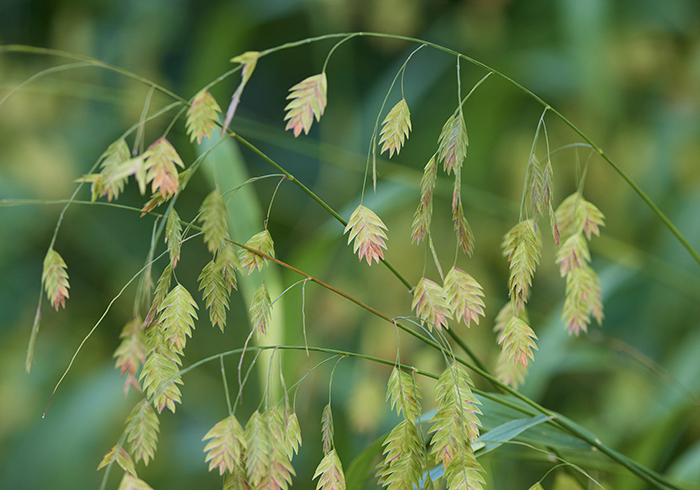Garden Talk

Botanical name: Chasmanthium latifolium
Common name: River oats
Family name: Poaceae (Grass family)
Native range: Eastern North America
Location in Duke Gardens: Blomquist Garden of Native Plants
USDA Hardiness Zones: 5-9
By Katherine Hale
Marketing & Communications Assistant
Anyone strolling along the banks of the Eno River and other waterways in central North Carolina in late summer and early fall will quickly spot the thick patches of river oats (Chasmanthium latifolium) lining the banks and the surrounding woodlands. If there’s any plant that encapsulates my experience of this season in the Piedmont—of being completely at home and grounded in my native landscape—it’s this one, especially once its distinctive flat seed heads are on full display.
River oats are native perennial bunchgrasses, which means that each plant grows in thick clumps instead of spreading out across a wide area like turf grasses do. Their leaves die back each winter and are replaced by new growth in the spring, eventually topping out at 2 to 5 feet, depending on soil conditions. Although they prefer moist, well-drained soil in full sun, they can also tolerate part shade, making them highly adaptable to a wide range of garden settings.
As you might imagine from their name, river oats’ most striking feature are their distinctive flat seed heads, which are reminiscent of the oats you might eat for breakfast (Avena sativa). Not only do these seedheads cause the stems to nod gracefully and sway in the wind, their unique shape makes this one of the easiest grass species to identify on sight, without the need for field guides or flora. They’ve also earned the plant the moniker “fish-on-a-pole grass” because of their resemblance to a string of fish dangling from a line. I love to cut the stems of the plants in my own garden and incorporate them into flower arrangements for a beautiful and local touch.
Like other native plants, river oats are part of the food web for many different species, especially their seeds, which are a welcome food source in fall and winter for many small mammals and small birds. They are also host to northern pearly-eye butterfly caterpillars (Lethe anthedon), as well as several species of skipper butterflies (family Hesperiidae) that feed on members of the grass family. The only animals that don't like river oats are deer, as they generally find the tough, bamboo-like leaves unpalatable.
River oats superficially resemble sea oats (Uniola paniculata), whose roots protect coastal sand dunes from erosion and storm damage. In fact, botanists once classified river oats as U. latiflora, only to later move to them to the genus Chasmanthium, which is Greek for “wide, gaping flower”—yet another reference to the unique shape of their seedheads.
Because of their tendency to form dense colonies, river oats are best suited for mass plantings or borders where they won’t crowd out less vigorous plants. Look for them in the Blomquist Garden of Native Plants near the banks of the Sunny Pond and along many of the paths nearby.
Photos from top: River oats seedheads in the Blomquist Garden of Native Plants, by Cathi Bodine; close-up of river oats seedheads as they approach maturity, by Peter Jeff Nicholls.






